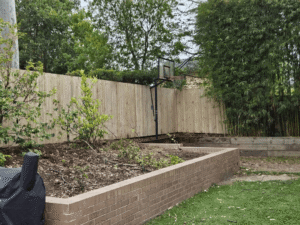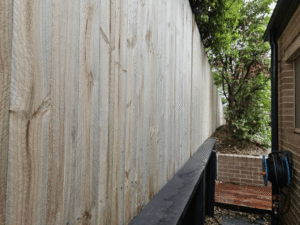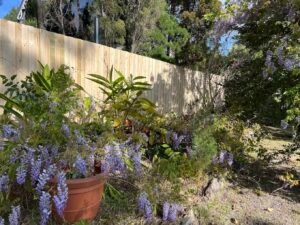Among the various types of retaining walls available, “sleeper retaining walls” have gained popularity for their versatility. These walls, constructed using timber sleepers, offer an intriguing blend of form and function. making them an attractive choice for a wide range of landscaping projects.
The Anatomy
Sleeper retaining walls are constructed using timber sleepers, which are large, rectangular blocks of wood often derived from hardwoods.These sleepers are placed horizontally or vertically to create a sturdy barrier that holds back soil on elevated terrains. One of the key advantages of these retaining walls is their adaptability to various landscapes, as they can be constructed in straight lines, curves, or even zig-zag patterns to complement the natural flow of the terrain.
Aesthetic Appeal
Sleeper retaining walls exude a distinct rustic charm that can instantly elevate the visual appeal of any outdoor space. The natural texture and warmth of wood create an inviting atmosphere, making these walls particularly suitable for both traditional and modern landscape designs. With various timber options available, homeowners can select the wood that best complements their existing outdoor elements, be it a timber deck, garden furniture, or other wooden structures.
Versatility in Design
One of the standout features of sleeper retaining walls is their adaptability in design. These walls can be employed to create multi-level terraces, offering functional spaces for gardening, seating areas, or even play zones for children. The ability to combine functionality with aesthetics makes these walls an essential tool in optimizing outdoor spaces, especially in sloped or uneven terrains.
Eco-Friendly Choice
In an era where environmental consciousness is paramount, sleeper retaining walls offer an eco-friendly solution. Timber sleepers are a renewable resource, and when sourced responsibly, they can have a significantly lower carbon footprint compared to walls constructed from concrete or metal. Additionally, the use of wood in landscaping contributes to a natural and harmonious ambiance, promoting a connection between outdoor spaces and the environment.
Ease of Construction
Sleeper retaining walls are favored for their relative ease of construction compared to more complex materials like stone or concrete. Depending on the scale of the project, DIY enthusiasts with basic carpentry skills can take on sleeper wall construction. However, for larger or more intricate projects, it’s recommended to consult professionals to ensure proper structural integrity and longevity.
Maintenance and Longevity
To maintain the longevity of sleeper retaining walls, proper treatment is essential. Treated timber sleepers are resistant to decay, pests, and fungal growth, but periodic maintenance such as resealing or staining is recommended to preserve their appearance and structural integrity. Regular inspection for any signs of wear, erosion, or movement is crucial to address potential issues early and prevent larger problems.
Sleeper retaining walls seamlessly blend functionality and aesthetics, making them an appealing choice for landscape architects, designers, and homeowners alike. With their versatility, rustic charm, and eco-friendly attributes, these walls not only hold back soil and create usable spaces but also contribute to the overall visual appeal of outdoor environments. Whether framing garden beds, creating terraces, or enhancing a property’s curb appeal, sleeper retaining walls stand as a testament to the harmonious marriage of design and purpose in landscaping. if you need our help in this case, book a quote!




